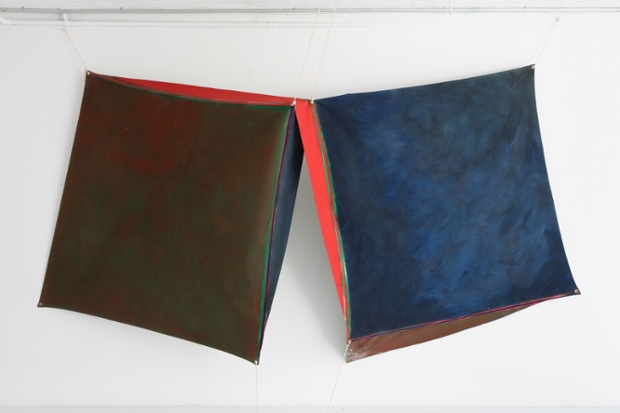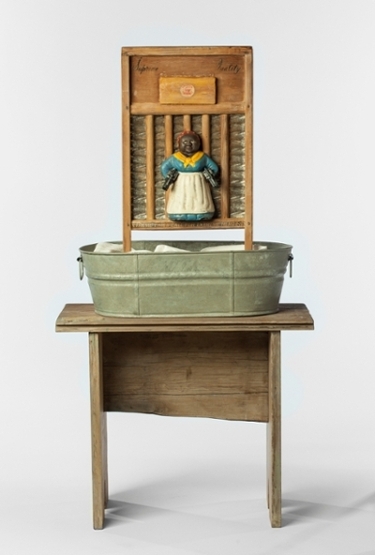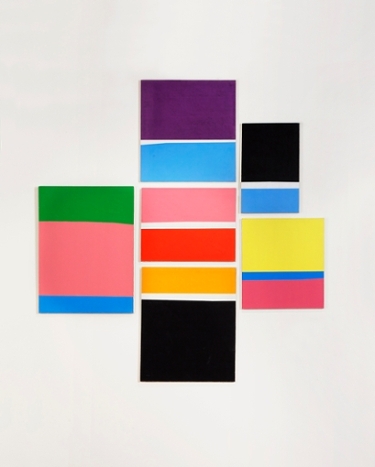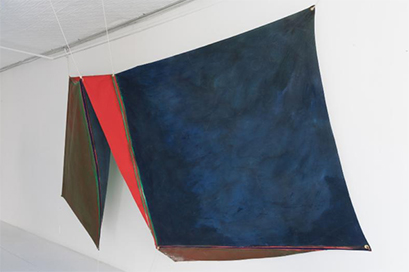Works by prominent artists enter The Rose Art Museum's permanent collection
Three major works have newly entered the museum’s permanent collection
 © 2019 Joe Overstreet / Artists Rights Society (ARS), New York. Courtesy of Eric Firestone Gallery, New York
© 2019 Joe Overstreet / Artists Rights Society (ARS), New York. Courtesy of Eric Firestone Gallery, New YorkJoe Overstreet,Untitled, 1972, Rose Art Museum at Brandeis University, Mortimer and Sara Hays Endowment Fund, Rose Art Museum Special Fund
The Rose Art Museum has announced that three major works have newly entered the museum’s permanent collection. The most recent acquisitions purchased with funds from museum endowments include Betye Saar’s mixed media assemblage Supreme Quality (1998), Ralph Coburn’s multi-part painting Random Sequence Participatory Composition (1962), and Joe Overstreet’s monumental sculptural painting untitled (1972) from the Flight Patterns series. These important works add further depth to
Other recent notable purchases include pieces by Cypriot artist Haris Epaminonda, who recently received the Silver Lion at the Venice Biennale, American emerging artist Martine Gutierrez, and Belgian artist Pieter Vermeersch, whose work enters a U.S. Museum’s collection for the first time. Of the fifteen works added in 2019 alone, 67 percent were works by women and 53 percent were works by artists of color, in a group that includes multiple generations, ethnicities, and backgrounds.
Commenting on the recent acquisitions, Henry and Lois Foster Director and Chief Curator Luis Croquer stated: “We are thrilled to welcome Betye Saar, Ralph Coburn, and Joe Overstreet’s exceptional work to the Rose collection. These pieces add greater depth and new perspectives to our

Supreme Quality, 1998, Rose Art Museum at Brandeis University, 2019.
(b. 1926, Los Angeles, CA)
Supreme Quality, 1998
A pioneer of second-wave feminist and post-war black aesthetics, Betye Saar (b. 1926, Los Angeles, CA) began a career in design before transitioning to assemblages and installations, for which she is best known. In 1972, she created her first series of assemblages, often depicting African American women in revolt against enslavement, segregation, and servitude. With the figure of an armed woman at its center, Supreme Quality is part of a series of assemblages built with salvaged washboards that the artist has collected for almost 60 years. Saar uses the outmoded household tool as a symbol of the unresolved legacy of slavery and the subsequent oppressive systems facing Black Americans today, particularly the plight of women. In her work, the washboard, a humble everyday object, speaks to both labor and historical trauma. Saar’s boundary-pushing practice has now served as a major influence for many generations of artists that have followed in her footsteps.
About the Artist
Born in Los Angeles, Saar moved with her family to Pasadena in the early 1930s. After graduating in 1949 from the University of California, Los Angeles, where she studied interior design, she built an arts community with two recent Los Angeles transplants, jewelry designer Curtis Tann and artist William Pajaud. Inspired by the assemblage-based practice of other Los Angeles artists, Saar began the practice for which she is best known. Saar’s appropriation and reuse of cultural materials and racist stereotypes

Ralph Coburn, Random Sequence Participatory Composition, 1962, Rose Art Museum at Brandeis University, Rose Endowed Art Purchase Fund and Rose Art Museum Special Fund, 2019.
Ralph Coburn
(b. 1923, Minneapolis, MN; d. 2018, Miami, FL)
Random Sequence Participatory Composition, 1962
Originally trained as an architect at MIT in the 1940s, Ralph Coburn (b. 1923, Minneapolis, MN; d. 2018, Miami, FL) worked outside the mainstream in Boston, exploring ideas of seriality, authorship, subjectivity, and participatory aesthetics. His graphic color-block paintings often derive from motifs in
“Not enough people know about Coburn’s work, which is spare, beautiful, witty, and uncannily satisfying,” wrote Boston Globe critic Sebastian Smee. Random Sequence Participatory Composition is one of a few remaining and intact participatory compositions by Coburn.
About the Artist
Ralph Coburn was born in Minneapolis, Minnesota in 1923, and grew up in Miami in a house overlooking Biscayne Bay, offering unparalleled views that Coburn perceived visually in elemental forms. In 1941 Coburn enrolled in MIT’s School of Architecture and Planning, where key connections introduced him to major figures of the avant-garde. After being rejected by the army, Coburn found employment as a draftsman for the Air Force at the Miami Air Depot. After the war, Coburn moved back to Boston, planning to return to MIT to complete his architectural degree. However—drawn by his love for art—he decided to pursue a career as a painter. During the 1970s, Coburn exhibited in Boston occasionally, but his early works remained unknown. In 2002, some of his early pieces were included in the exhibition The Visionary Decade — New Voices in Art in 1940s Boston, held at Boston University: the first time the work of his youth was shown publicly. To this day his work remains largely underrecognized.

Joe Overstreet,Untitled, 1972, Rose Art Museum at Brandeis University, Mortimer and Sara Hays Endowment Fund, Rose Art Museum Special Fund.
(b. 1933, Conehatta, MS)
Untitled, 1972
With a career spanning seven decades, Joe Overstreet (b. 1933, Conehatta, MA; d. 2019, New York, NY) can only be defined as an artist committed to relentless experimentation and the investigation of both complex cultural histories and paintings’ spatial possibilities. Born in rural and deeply segregated Mississippi, Overstreet grew up in the Bay Area, where he attended the California School of Fine Arts and California School of Arts and Crafts and became a fixture of the progressive Beat Generation in the North Beach section of California. He was part of an art scene that included Nathan Oliveira, Richard Diebenkorn, and Sargent Johnson. A mentor to Overstreet, Johnson advocated that African-American artists synthesize the influence of their ancestral legacy within a modern aesthetic practice. In the late 1960s, after a move to New York City, Overstreet—like other artists of this moment—began to create paintings freed from the constraints of the rectangular stretcher and frame and by the early 1970s was sewing canvases that were suspended by ropes attached to surrounding planes: ceiling, walls, floor. Architectural in scale, the paintings in Overstreet’s 1970-72 Flight Pattern series—to which Untitled (1972) belongs—reference the dynamism of free Jazz while evoking the artist’s own personal visual language.
About the Artist
Born in tiny Conehatta, Mississippi, Overstreet grew up in California and studied art in the Bay Area, where he gravitated toward the Beat scene. After briefly working in Los Angeles as an animator for Walt Disney, he moved to New York’s Lower East Side. In the mid-1960s, he became the art director of the Black Arts Repertory Theatre and School, founded in Harlem by Amiri Baraka. In 1974, Overstreet and his partner Corrine Jennings established Kenkeleba House, an art center in Lower Manhattan dedicated to the supporting and exhibiting the work of underrepresented and emerging artists. Overstreet’s work can be found in the collections of the Brooklyn Museum, the Everson Museum, and the Menil Collection, among others. Since the 1960s, Overstreet has been part of
Categories: Arts





